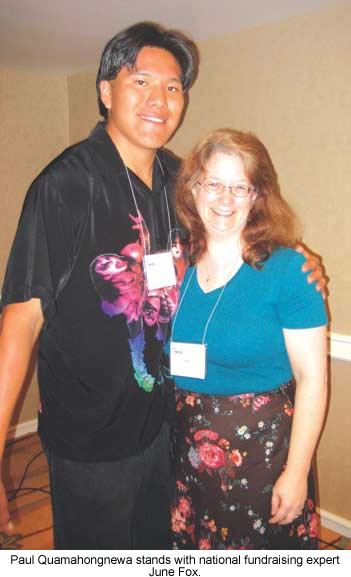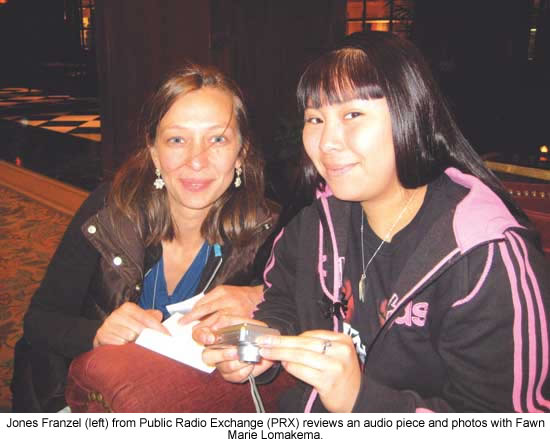 |
Canku Ota
|
 |
|
(Many Paths)
|
||
|
An Online Newsletter
Celebrating Native America
|
||
|
May 1, 2009 - Volume
7 Number 5
|
||
|
|
||
|
Hopi High Students
Attend Broadcasters Conference
|
||
|
from The Navajo-Hopi
Observer
|
||
|
credits: Photos courtesy
of The Navajo-Hopi Observer
|
|
Students Nicole Sockyma, Fawn Marie Lomakema, Paul Quamahongnewa and Tarrah Tewanema kicked off the youth section with their performance. Sockyma
and Quamahongnewa gave a presentation to the youth section that
included groups from Boston, Mass; Oakland, Calif; and Washington
State. The presentation focused on the Hopi High Teen Show, which is the only live remote Native American teen talk show in the nation on KUYI, the Hopi community radio station. Lomakema interviewed Eitan Stern-Robbins from Terrascope radio (http://web.mit.edu/tyr) out of Boston. Stern-Robbins said their radio program focuses on scientific environmental issues. "I like radio because I like talking and I get paid," he said. "I want my voice to be heard." Lomakema received many positive comments from radio critics in the room. Jones Franzel, project director of Generation X for Public Radio Exchange (prx.org) said it took courage for Lomakema to interview somebody in front of a roomful of radio folks. To start the youth session, Tewanema led icebreakers. One icebreaker involved naming movies. When Jerome Edge missed the answer he performed the chicken dance for the crowd. Edge, who has a radio show on KSVR (www.ksvr.org) in Washington, earlier said, "Radio is poetry in motion." The chicken dance may not have been the motion that he had in mind.
Franzel spoke about how to do pieces for PRX, which has more than 900 youth pieces on their site. Quamahongnewa previously served on the PRX editorial board where he reviewed six youth pieces a month. He is in the advanced radio class, but also works at KUYI and serves on the KUYI Community Advisory Board. "It takes courage to share and to give feedback," Franzel said about Quamahongnewa and others who serve on the PRX Editorial Board. Fox, a national fundraising expert, helps community radio stations throughout the nation. She has a special place in her heart for high school radio students because that is where she started. Fox, who has a BA in journalism and radio from the University of Maryland, told students that the most important tool in fundraising is to ask because so many times people don't ask. Fox told the students that radio is an "addiction" for most in the field. "We love what we do and we can't imagine doing anything else," she said. Fox said most of the money in radio is made by engineers, salesmen and management. She said she doesn't consider her job work. "I never worked a day in my life because I play with friends each day," she said. Fox said about 280 radio stations pay her a fee to obtain the tools and techniques about how they can raise funds. Myers, program director at Youth Radio in Oakland, (youthradio.org) told the students that Youth Radio has offices in Atlanta, Ga.; Washington, D.C.; Los Angeles and Oakland. They hope to bring a diversity of youth opinions to the airwaves. Shaw Killip, also part of Youth Radio, talked about the Community Action Program which teaches youth who were on probation to use radio to help themselves. Denise Tejada, another member of Youth Radio, told about how Youth Radio covered the recent shooting of a 22 year old by a transit officer. Myers told the students that it's important in today's world that they use not just the airwaves but the multimedia of including the Internet, so it's important to use a movie camera, a still camera and a microphone. He noted that National Public Radio has been firing people at a time when the Internet companies are hiring. Youth Radio recorded audio and video of the youth students performing the moonwalk and the macarana. Stan Bindell, radio teacher at Hopi High, praised the radio students. "I am extremely proud of my radio students. I think they put their best foot forward to express themselves, but they also act in a professional manner. They are doing a good job of preparing for the radio world whether it's majoring in radio or working at a radio station." Hopi High Principal Glenn Gilman said he thanks Bindell for taking the students to the conference. "I appreciate his dedication and commitment to the Hopi High School radio and journalism program," he said. Principal Gilman said he believes the students benefited extensively from the exposure they received at this conference. The Hopi High students also had a chance to get out in Portland including a trek on the river walk where they happened to run into Channel 12 Newscaster Bill Hyde. Hyde shared his thoughts with the radio students, telling them that Portland is the 24th largest television market. He said Portland is a good city with plenty of culture including art galleries. They also had a chance to meet with many radio professionals including Burt Poley from Native Voice 1, John Gregg, Victor Aronow from Arizona Community Foundation and Brian Brashier from Chickasaw Community Radio. The Hopi High radio students thank the funders for the trip which included Hopi High School, Apollo College, Navajo Hopi Observer, former Hopi Vice Chairman Todd Honyaoma Sr., fundraising expert June Fox, Cynthia Yurth, Tom and Jane Scholes, Greg and Sandy Schnirring and Navajo Nation Speaker Lawrence T. Morgan. |
| View Larger Map |
|
|
||
|
|
||
| Canku Ota is a free Newsletter celebrating Native America, its traditions and accomplishments . We do not provide subscriber or visitor names to anyone. Some articles presented in Canku Ota may contain copyright material. We have received appropriate permissions for republishing any articles. Material appearing here is distributed without profit or monetary gain to those who have expressed an interest. This is in accordance with Title 17 U.S.C. Section 107. | ||
|
Canku Ota is a copyright ©
2000, 2001, 2002, 2003, 2004, 2005, 2006, 2007, 2008, 2009 of Vicki
Barry and Paul Barry.
|
||
 |
 |
|
|
The "Canku
Ota - A Newsletter Celebrating Native America" web site and
its design is the
|
||
|
Copyright ©
1999, 2000, 2001, 2002, 2003, 2004, 2005,
2006, 2007, 2008 of Paul C.
Barry.
|
||
|
All Rights Reserved.
|
||
 PORTLAND,
Ore. - Four Hopi High radio students gave presentations at the 34th
annual National Federation of Community Broadcasters (NFCB) Conference
at the Hilton Portland and Executive Tower. Approximately 350 people
attended the conference.
PORTLAND,
Ore. - Four Hopi High radio students gave presentations at the 34th
annual National Federation of Community Broadcasters (NFCB) Conference
at the Hilton Portland and Executive Tower. Approximately 350 people
attended the conference.  The
Hopi High students were among the youth that received training from
June Fox, Franzel and Brett Myers, producer of youth programs at
Youth Radio in Oakland.
The
Hopi High students were among the youth that received training from
June Fox, Franzel and Brett Myers, producer of youth programs at
Youth Radio in Oakland.